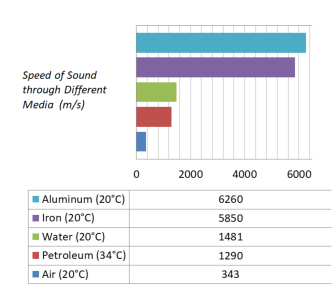SLAA907D September 2019 – December 2021 PGA450-Q1 , PGA460 , PGA460-Q1 , TDC1000 , TDC1000-Q1 , TDC1011 , TDC1011-Q1 , TUSS4440 , TUSS4470
3.1 Transmission Medium
Transmission properties, and the speed of sound, change across different mediums. An ultrasonic sensor is optimized for sound wave propagation through air, liquids, or solids, but rarely for more than one type of transmission medium. Ultrasonic attenuation in the air increases as a function of frequency, so air-coupled ultrasonic applications are limited to frequencies below 500 kHz. Liquid and solid applications can use transducers in the low MHz range for high-accuracy applications.
 Figure 3-1 Speed of Sound Through Different Media
Figure 3-1 Speed of Sound Through Different Media